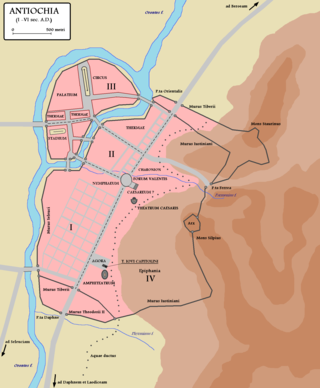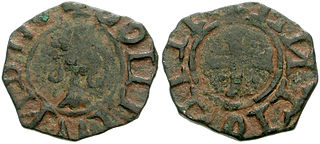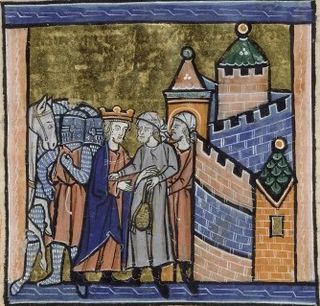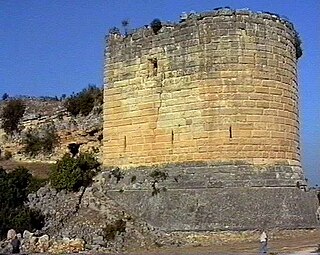
Antioch on the Orontes was a Hellenistic Greek city founded by Seleucus I Nicator in 300 BC. It was one of the greatest and most important Greek cities of the Hellenistic period. The city served as the capital of the Seleucid Empire and later as regional capital to both the Roman and Byzantine Empire. During the Crusades, Antioch served as the capital of the Principality of Antioch, one of four Crusader states that were founded in the Levant. Its inhabitants were known as Antiochenes. The modern city of Antakya, in Hatay Province of Turkey, was named after the ancient city, which lies in ruins on the Orontes River and did not overlap in habitation with the modern city.

The Eighth Crusade was the second Crusade launched by Louis IX of France, this one against the Hafsid dynasty in Tunisia in 1270. It is also known as the Crusade of Louis IX Against Tunis or the Second Crusade of Louis. The Crusade did not see any significant fighting as King Louis died of dysentery shortly after arriving on the shores of Tunisia. The Treaty of Tunis was negotiated between the Crusaders and the Hafsids. No changes in territory occurred, though there were commercial and some political rights granted to the Christians. The Crusaders withdrew back to Europe soon after.

Bohemond II was Prince of Taranto from 1111 to 1128 and Prince of Antioch from 1111/1119 to 1130. He was the son of Bohemond I, who in 1108 was forced to submit to the authority of the Byzantine Empire in the Treaty of Devol. Three years later, the infant Bohemond inherited the Principality of Taranto under the guardianship of his mother, Constance of France. The Principality of Antioch was administered by his father's nephew, Tancred, until 1111. Tancred's cousin, Roger of Salerno, managed the principality from 1111 to 1119. After Roger died in the Battle of the Field of Blood, Baldwin II of Jerusalem took over the administration of Antioch. However, he did acknowledge Bohemond's right to personally rule the principality upon reaching the age of majority.

Baldwin II, also known as Baldwin of Bourcq or Bourg, was Count of Edessa from 1100 to 1118, and King of Jerusalem from 1118 until his death. He accompanied his cousins Godfrey of Bouillon and Baldwin of Boulogne to the Holy Land during the First Crusade. He succeeded Baldwin of Boulogne as the second count of Edessa when he left the county for Jerusalem following his brother's death. He was captured at the Battle of Harran in 1104. He was held first by Sökmen of Mardin, then by Jikirmish of Mosul, and finally by Jawali Saqawa. During his captivity, Tancred, the Crusader ruler of the Principality of Antioch, and Tancred's cousin, Richard of Salerno, governed Edessa as Baldwin's regents.

The Principality of Antioch was one of the Crusader states created during the First Crusade which included parts of modern-day Turkey and Syria. The principality was much smaller than the County of Edessa or the Kingdom of Jerusalem. It extended around the northeastern edge of the Mediterranean, bordering the County of Tripoli to the south, Edessa to the east, and the Byzantine Empire or the Kingdom of Armenia to the northwest, depending on the date.
Hugh III, also called Hugh of Antioch-Lusignan and the Great, was the king of Cyprus from 1267 and king of Jerusalem from 1268. Born into the family of the princes of Antioch, he effectively ruled as regent for underage kings Hugh II of Cyprus and Conrad III of Jerusalem for several years. Prevailing over the claims of his cousin Hugh of Brienne, he succeeded both young monarchs upon their deaths and appeared poised to be an effective political and military leader.

Leo II was the tenth lord of Armenian Cilicia, ruling from 1187 to 1219, and the first king to be crowned, in 1198/9. During his reign, Leo succeeded in establishing Cilician Armenia as a powerful and unified Christian state with a pre-eminence in political affairs. Leo eagerly led his kingdom alongside the armies of the Third Crusade and provided the crusaders with provisions, guides, pack animals and all manner of aid. Under his rule, Armenian power in Cilicia was at its apogee: his kingdom extended from Isauria to the Amanus Mountains.

Bohemond III of Antioch, also known as Bohemond the Child or the Stammerer, was Prince of Antioch from 1163 to 1201. He was the elder son of Constance of Antioch and her first husband, Raymond of Poitiers. Bohemond ascended to the throne after the Antiochene noblemen dethroned his mother with the assistance of the lord of Armenian Cilicia, Thoros II. He fell into captivity in the Battle of Harim in 1164, but the victorious Nur ad-Din, atabeg of Aleppo released him to avoid coming into conflict with the Byzantine Empire. Bohemond went to Constantinople to pay homage to Manuel I Komnenos, who persuaded him to install a Greek Orthodox patriarch in Antioch. The Latin patriarch of Antioch, Aimery of Limoges, placed Antioch under interdict. Bohemond restored Aimery only after the Greek patriarch died during an earthquake in 1170.

Bohemond IV of Antioch, also known as Bohemond the One-Eyed, was Count of Tripoli from 1187 to 1233, and Prince of Antioch from 1201 to 1216 and from 1219 to 1233. He was the younger son of Bohemond III of Antioch. The dying Raymond III of Tripoli offered his county to Bohemond's elder brother, Raymond, but their father sent Bohemond to Tripoli in late 1187. Saladin, the Ayyubid sultan of Egypt and Syria, conquered the county, save for the capital and two fortresses, in summer 1188.
Bohemond VI, also known as the Fair, was the prince of Antioch and count of Tripoli from 1251 until his death. He ruled while Antioch was caught between the warring Mongol Empire and Mamluk Sultanate. He allied with the Mongols against the Muslim Mamluks and his Crusaders fought alongside the Mongols in their battles against the Mamluks. The Mamluks would achieve a historic victory against the Mongols and halt their advance westwards at the Battle of Ain Jalut. In 1268 Antioch was captured by the Mamluks under Baybars, and he was thenceforth a prince in exile. He was succeeded by his son, Bohemond VII.
Raymond-Roupen was a member of the House of Poitiers who claimed the thrones of the Principality of Antioch and Armenian Kingdom of Cilicia. His succession in Antioch was prevented by his paternal uncle Bohemond IV, but his maternal great-uncle Leo I of Cilicia recognized him as heir presumptive to Cilicia and pressed his claim to Antioch. In 1211 Raymond-Roupen was crowned junior king of Cilicia, and was finally installed as Prince of Antioch in 1216. The War of the Antiochene Succession ended with Leo's death in 1219, shortly before Raymond-Roupen was ousted from Antioch. He then pursued his claim to Cilicia, which Leo had unexpectedly willed to his daughter Isabella on his deathbed, but was defeated and imprisoned until death.

The Battle of Harran took place on 7 May 1104 between the Crusader states of the Principality of Antioch and the County of Edessa, and the Seljuk Turks. It was the first major battle against the newfound Crusader states in the aftermath of the First Crusade, marking a key turning point against Frankish expansion. The battle had a disastrous effect on the Principality of Antioch as the Turks regained territory earlier lost.

The siege of Antioch took place during the First Crusade in 1097 and 1098, on the crusaders' way to Jerusalem through Syria. Two sieges took place in succession. The first siege, by the crusaders against the city held by the Seljuk Empire, lasted from 20 October 1097 to 3 June 1098. The second siege, of the crusader-held city by a Seljuk relieving army, lasted three weeks in June 1098, leading to the Battle of Antioch in which the crusaders defeated the relieving army led by Kerbogha. The crusaders then established the Principality of Antioch, ruled by Bohemond of Taranto.
Sibylla of Armenia was the princess of Antioch and countess of Tripoli by marriage to Bohemond VI from 1254 to 1275, and then regent of the County of Tripoli until their son, Bohemond VII, came of age in 1277. She was closely allied with the bishop of Tortosa, Bartholomew Mansel, which frustrated the scheme to install her as ruler of Tripoli instead of her daughter Lucia after Bohemond VII's death in 1287. During her lifetime, both the principality and the county were lost to the Egyptian Mamluks.

The 1271 siege of Tripoli was initiated by the Mamluk ruler Baibars against the Frankish ruler of the Principality of Antioch and the County of Tripoli, Bohemond VI. It followed the dramatic fall of Antioch in 1268, and was an attempt by the Mamluks to completely destroy the Crusader states of Antioch and Tripoli.

The siege of Shaizar took place from April 28 to May 21, 1138. The allied forces of the Byzantine Empire, Principality of Antioch and County of Edessa invaded Muslim Syria. Having been repulsed from their main objective, the city of Aleppo, the combined Christian armies took a number of fortified settlements by assault and finally besieged Shaizar, the capital of the Munqidhite Emirate. The siege captured the city, but failed to take the citadel; it resulted in the Emir of Shaizar paying an indemnity and becoming the vassal of the Byzantine emperor. The forces of Zengi, the greatest Muslim prince of the region, skirmished with the allied army but it was too strong for them to risk battle. The campaign underlined the limited nature of Byzantine suzerainty over the northern Crusader states and the lack of common purpose between the Latin princes and the Byzantine emperor.

Koz Castle, or Kürşat Castle is a castle in the Altınözü district of the Hatay Province of Turkey, built on a small hill where the Kuseyr Creek starts. It was built by the Principality of Antioch out of ashlar. The castle used to have a gate to the north, but this gate no longer exists and the eastern side of the castle has been leveled, with some original barns left. Some bastions of the castle stand to this day.

The War of the Antiochene Succession, also known as the Antiochene War of Succession, comprised a series of armed conflicts in northern Syria between 1201 and 1219, connected to the disputed succession of Bohemond III of Antioch. The Principality of Antioch was the leading Christian power in the region during the last decades of the 12th century, but Armenian Cilicia challenged its supremacy. The capture of an important fortress, Bagras, in Syria by Leo II of Cilicia gave rise to a prolonged conflict already in the early 1190s. Leo tried to capture Antioch, but the Greek and Latin burghers formed a commune and prevented the Armenian soldiers from occupying the town. Bohemond III's eldest son, Raymond, died in 1197, leaving an infant son, Raymond-Roupen. The boy's mother, Alice of Armenia, was Leo I's niece and heir presumptive. Bohemond III and the Antiochene noblemen confirmed Raymond-Roupen's right to succeed his grandfather in Antioch, but the commune preferred Bohemond III's younger son, Bohemond, Count of Tripoli.

The fall of Outremer describes the history of the Kingdom of Jerusalem from the end of the last European Crusade to the Holy Land in 1272 until the final loss in 1302. The kingdom was the center of Outremer—the four Crusader states—formed after the First Crusade in 1099 and reached its peak in 1187. The loss of Jerusalem in that year began the century-long decline. The years 1272–1302 are fraught with many conflicts throughout the Levant as well as the Mediterranean and Western European regions, and many Crusades were proposed to free the Holy Land from Mamluk control. The major players fighting the Muslims included the kings of England and France, the kingdoms of Cyprus and Sicily, the three Military Orders and Mongol Ilkhanate. Traditionally, the end of Western European presence in the Holy Land is identified as their defeat at the Siege of Acre in 1291, but the Christian forces managed to hold on to the small island fortress of Ruad until 1302.
Simon Mansel was a Constable of Antioch.














